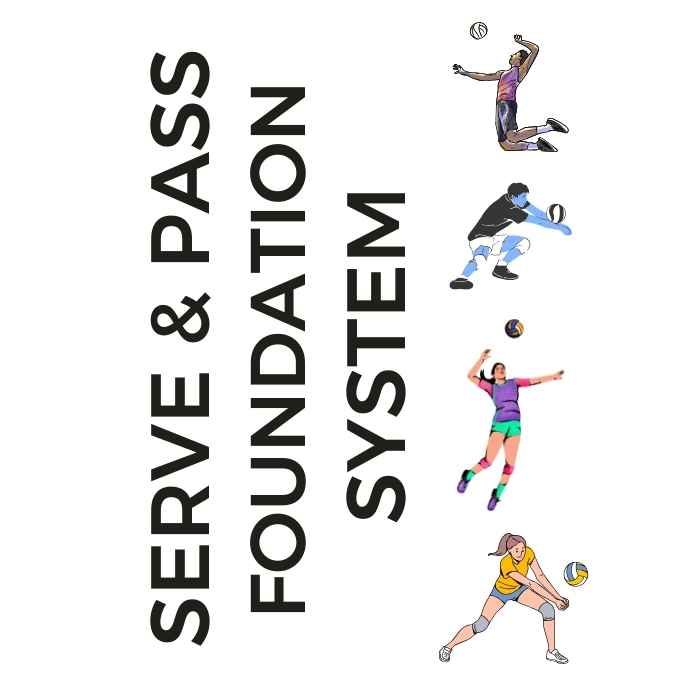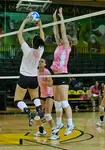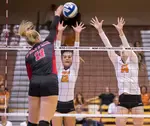
Serve + Pass Foundation System: The Complete Skills Arsenal The two-skill mastery system that transforms inconsistent players into the athletes coaches build their lineups around. Stop Struggling With The Two Most Important Skills In Volleyball!
- Improve Your Volleyball with Coach April
- Whats the Volleyball Court Size?
- Basic Volleyball Rules and Terminology
Learn The Basic Volleyball Rules and Terminology: A Beginner's Guide
Learn more on the basic volleyball rules and terminology for the antenna, what's the volleyball net and how high is it and where's the front and back court?
 The volleyball court. We dive on it, we hit on it, we block on it, and we serve on it but do we really know all the important basic volleyball rules and terminology of the court we play this game on? (diagram by grifone87)
The volleyball court. We dive on it, we hit on it, we block on it, and we serve on it but do we really know all the important basic volleyball rules and terminology of the court we play this game on? (diagram by grifone87)Volleyball is an exciting and fast-paced sport enjoyed by millions worldwide.
Whether you're a new player or a spectator, understanding the basic rules and terminology is essential to fully appreciate the game.
In this article, we'll explore the fundamental aspects of volleyball, including the court layout, net specifications, the roles of the front and back court players, scoring, and serving.
By the end of this guide, you'll have a solid foundation of volleyball knowledge to help you enjoy the game even more.
The Volleyball Court Layout: Key Components and Dimensions
The volleyball court is a rectangular area measuring 18 meters (59 feet) long and 9 meters (29.5 feet) wide, divided into two equal halves by a net.
The court is marked with various lines, including the sidelines, end lines, attack line, and center line.
I've explained a lot of the basic parts of the indoor court in this article including the
The Antenna: A Crucial Element in Basic Volleyball Rules and Terminology
The antenna is a vital component of the volleyball net setup.
They extend vertically from the top of the net to the ceiling and down to the floor.
The ball must pass between these antennae during serves, hits, and spikes for the play to be considered valid.
If the ball touches or crosses outside the antennae, it is deemed out of bounds.
What is the Antenna?
There are two antennae for each volleyball court, that are usually made of red and white striped plastic or a type of fiberglass.
They are attached to the net and represent a vertical extension of the sideline of that extends up above them to the ceiling and below them to the floor.
When a player serves the ball or when teams hit or spike, the ball must pass between these two antennae in order for play to be valid otherwise the ball is out of bounds.
The Volleyball Net: Height and Specifications in Basic Volleyball Rules and Terminology
The volleyball net is the centerpiece of the court, dividing it into two equal halves.
The net is made of square mesh and is 3 feet (1 meter) wide.
Players must serve, hit, or spike the ball over the net to earn a point or gain the right to serve.
What is the volleyball net?
The net is the portable apparatus that divides one court from the other and it's what players need to serve the ball over or hit the ball over in order to earn a sideout or score a point.
The Back Court: Positioning and Responsibilities in Basic Volleyball Rules and Terminology
The back court is the area behind the attack line, consisting of zones 1, 5, and 6.
Players in the back court, also known as the back row, are primarily responsible for defense and serve receive.
During serve receive, their main task is to pass the served ball accurately to the setter, enabling the team to run an offensive play.
Back court players can also attack the ball, provided they do not cross the attack line.
Where is the Back court?
The back court is the area behind the attack line and is reserved for the players who have rotated in to
- zone 1 which is the serving area located in the right back area of the court,
- zone 5 which is the left back area, or
- zone 6 which is the middle back area of the court.
While on defense, the primary responsibility of the players in the back court also known as the back row is to play defense behind their blockers who are at the net in the front court.
If they are in serve receive then the back court players main responsibility is to receive the served ball so that their front court or front row hitters can run an offensive play.
A player who is in one of the three back court zones is allowed to hit a ball across the net as long as he or she does not cross the attack line.
The Front Court: Attacking and Blocking Zones in Basic Volleyball Rules and Terminology
The front court is the area between the net and the attack line, made up of the zones 2, 3, and 4.
Front court players, or front row players, are responsible for attacking and blocking.
Zone 4, on the left side of the court, is typically occupied by the outside hitter, who is also a left-side blocker.
Zone 3, in the middle, is reserved for the middle hitter, who specializes in quick attacks and is the primary middle blocker.
Where is the front court? -
The front court is made up of three zones or three areas in which front row hitters are allowed to attack and block.
- Zone 2 is the right front area
- Zone 3 is middle front reserved usually for the player specialized in hitting from the center of the court and who is also the middle blocker and
- Zone 4 (my zone yayy!) is reserved for the outside hitter who is also the left side blocker.
On each side of the net, the ten foot line separates the front court from the back court and players who have rotated to the front row must stay between the net and the ten foot line which marks the front court boundaries on their side.
Scoring in Volleyball: Rally Scoring and Winning a Set
In modern volleyball, rally scoring is used, meaning a point is awarded on every rally, regardless of which team serves.
A team scores a point when they successfully put the ball on the opponent's court, or when the opposing team commits a fault, such as hitting the ball out of bounds or failing to return the ball over the net.
To win a set, a team must reach 25 points and lead by at least two points.
If the score is tied at 24 - 24, play continues until one team gains a two-point lead.
Matches are typically best-of-three or best-of-five sets.
Serving in Volleyball: Service Order, Rotation, and Basic Rules
Serving is the act of putting the ball into play after the referee whistles, by contacting the ball with one hand or arm from behind the end line of the court.
Addi works on her jump float serve toss consistency while aiming for a deep line serve to Zone 5.
The team that wins the rally or the previous point serves next.
After each side out (when the receiving team wins the rally), players rotate clockwise one position.
A serve must cross over the net and land inside boundaries of the opponent's court.
Common Violations in Volleyball: Net Touches, Foot Faults, and Double Hits
In volleyball, there are several common violations that players should be aware of.
A foot fault happens when a server steps on or crosses the end line before making contact with the ball during a serve.
A double hit, happens when a player makes two consecutive contacts with the ball, except when making the first team contact (during a serve reception or a dig).
These violations result in a point for the opposing team.
Player Positions and Roles: Setter, Libero, Outside Hitter, and More
Volleyball teams consist of six players on the court, each with specific roles and responsibilities.
The setter is the playmaker who orchestrates the team's offense by setting up attackers.
Outside hitters, also known as left-side hitters, attack from the left side of the court and are often the primary passers.
Middle blockers are tall, front-row players who specialize in blocking and quick attacks.
Opposite hitters, or right-side hitters, attack from the right side of the court and often play opposite the opponent's outside hitter.
Glossary of Common Volleyball Terms
Ace: A serve that directly results in a point, without the receiving team touching the ball.
- Dig: A defensive play in which a player prevents the ball from hitting the ground after an attack from the opposing team.
- Kill: An attack that results in an immediate point or a sideout.
I've trained with Cal Poly starting outside hitter Tommi Stockham on how to hit harder volleyball attacks when she was a junior in high school at Bishop Gorman.
-Sideout: When the receiving team wins the rally and gains the right to serve.
- Block: A defensive play at the net where one or more players attempt to intercept an attack from the opposing team.
- Rotation: The clockwise movement of players on the court after each sideout.
- Rally: The sequence of playing actions between teams from the moment the ball is served until a point is scored.
- Set: An overhead pass, usually performed by the setter, to position the ball for an attacker.
To Wrap Things Up...
Understanding basic volleyball rules and terminology, including scoring and serving, is the first step in enjoying this thrilling sport.
By familiarizing yourself with the court layout, net specifications, the roles of front and back court players, and the fundamentals of scoring and serving, you'll be better equipped to follow the game and appreciate the strategies employed by teams.
As you continue to watch or play volleyball, you'll naturally pick up more advanced terminology and nuances of the game.
Remember, the key to success in volleyball is effective communication, teamwork, and a solid grasp of the fundamentals.
Do You Follow Me on Pinterest?
Follow me on Pinterest Volleybragswag to improve your game even faster!
I share alot of individual, partner and easy-to-do volleyball serving drills we do in class with my followers.
Many of these volleyball practice drills you can do at home by yourself or try at your next practice with your teammates.
If you're a B team or JV player trying to make varsity next year...your goal should be to complete 1000 reps a day of at least three of the basic skills on your own...volleyball passing, serving and setting should be at the top of the list.
If your athlete struggles with consistent serve receive, gets subbed out, or is overlooked for playing time—this is the fix you’ve been looking for.

Struggling with passing consistency?
I help talented passers tired of getting pulled from games because of inconsistent serve receive skills BUILD passing confidence without expensive private lessons using the same 3-step system that's helped dozens of my athletes get recruited.
Download my eBook for $17.99 and start building the passing confidence that keeps you on the court—and gets you seen by college coaches.
From Lady Vol to Legend: Coach April Produces Powerful Passionate Players...is that you?
What Are You Looking For?
Click to Download Your Pre Serving Ritual Mastery Checklist pdf:
🎯Volleyball Pre Serving Ritual Guide -
Players! Learn How To Transform Your Serve from Weak to Weapon
Click to Download Your Parent's Volleyball Serving Checklist pdf
🎯Parent's Volleyball Serving Checklist Guide
Parents! Help Your Player Develop Championship Serves (Even If You've Never Played)

Hi there!
Thanks for stopping by. Hope you learned something today that will help you reach your volleyball goals.
Be sure to subscribe to my email newsletter so you can learn more each week!
Stay strong! Stay motivated!
-Coach April

SUSCRIBE to my email newsletter below!
 Click to learn more about the weekly volleyball classes and clinics or email info@imrpoveyourvolley.com for information
Click to learn more about the weekly volleyball classes and clinics or email info@imrpoveyourvolley.com for informationCongratulations to my seven Boys-18s Vegas Volley club players who played in two state championship finals yesterday, the 3A and 5A State champinship finals at Sunrise Mountain High School.
TOURNAMENT CHAMPIONS!
A-1 Vegas Volley VBC
In It To Win It Tournament
May 2 - 4, 2025 Tournament
Gold Medalists
18s Premier Division
Vegas Volleyball's Unsung Heroes: Celebrating Moms with Peace Love Volleyball Shirts
Ready to energize your volleyball mom journey?
Subscribe to my 'Producing Powerful Passionate Peaceful Players' email list above on ImproveYourVolley.com.
You'll receive energy-boosting tips, exclusive insights from me, Coach April Chapple on maintaining momentum in volleyball.
Let's power up the Vegas volleyball scene together!
Recent Articles
-
5 Essential Serving Tips from Tennessee's #2 Career Aces Record Holder
Dec 09, 25 11:39 PM
I've identified the 5 essential serving tips that separate confident servers from struggling ones and you'll serve with the confidence that creates aces -
The Volleyball Toss How Consistent Is Your Ball Toss Before You Serve?
Dec 07, 25 12:29 AM
The volleyball toss for the overhand serve needs to consistently be two feet up in the air and one foot in front of front foot which puts the ball in front of your serving arm. -
Shop Small: Real Volleyball Training With + Results From A Real Coach
Dec 03, 25 10:30 AM
Support a woman-owned business. Get training from a former elite pro with 13+ years coaching experience. Ditch the big box store--invest in proven results.
Bestselling
Volleyball Nets
on Sale!






























































